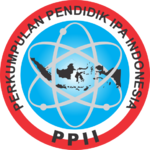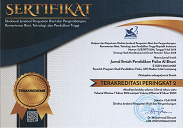Physics event photo analysis module based on the STEM approach: An effort to enhance critical thinking
Abstract
Keywords
Full Text:
PDFReferences
Ardianti, S., Sulisworo, D., Pramudya, Y., & Raharjo, W. (2020). The impact of the use of STEM education approach on the blended learning to improve student’s critical thinking skills. Universal Journal of Educational Research, 8(3B), 24–32. https://doi.org/10.13189/ujer.2020.081503
Broman, K., Bernholt, S., & Parchmann, I. (2018). Using model-based scaffolds to support students solving context-based chemistry problems. International Journal of Science Education, 40(10), 1176–1197. https://doi.org/10.1080/09500693.2018.1470350
Budi, A. P. S., Sunarno, W., & Sugiyarto. (2018). Natural science modules with SETS approach to improve students’ critical thinking ability. Journal of Physics: Conference Series, 1022, 012015. https://doi.org/10.1088/1742-6596/1022/1/012015
Darma, R. S., Setyadi, A., Wilujeng, I., Jumadi, & Kuswanto, H. (2019). Multimedia learning module development based on SIGIL software in physics learning. Journal of Physics: Conference Series, 1233, 012042. https://doi.org/10.1088/1742-6596/1233/1/012042
Fajarini, A. 2018. Membongkar rahasia pengembangan bahan ajar IPS. IAIN Jember.
Farihah, M. J., Norawi, A. M., & Jahan, A. N. (2021). Game-based STEM module development for KSSM science teachers. Journal of Turkish Science Education, 18(2), 249–262. https://doi.org/10.36681/tused.2021.63
Fouryza, D., Amin, S. M., & Ekawati, R. (2019). Designing lesson plan of integer number operation based on fun and easy math (FEM) approach. International Journal of Evaluation and Research in Education, 8(1), 103–109.
Hake, R. R. (2002). Relationship of individual student normalized learning gains in mecahnics with gender, high-school physics, and pretest scores on mathematics and spatial visualization. The Physics Education Research Conference: 1-14.
Halim, H., & Haidir, H. (2019). Penelitian pendidikan. Kencana
Hidayati, T. (2018). Pengembangan perangkat pembelajaran matematika dengan suplemen history of mathematics. Pena Persada.
Jeong, H.-S., & Park, J.-W. (2011). Practical suggestions for the effective use of everyday context in teaching physics -based on the analysis of students’ learning processes. Journal of The Korean Association for Science Education, 31(7), 1025–1039. https://doi.org/10.14697/jkase.2011.31.7.1025
Khotimah, R. P., Ahmad, C. N. C., Adnan, M., & Murtiyasa, B. (2021). The development of STEM-discovery learning module in differential equations: A need analysis. Review of International Geographical Education Online, 11(4), 941–950. https://doi.org/10.33403/rigeo.8006808
Kustandi, C., & Darmawan, D. (2020). Pengembangan media pembelajaran. Kencana.
Lestari, D. A. B., Astuti, B., & Darsono, T. (2018). Implementasi LKS dengan pendekatan STEM (science, technology, engineering, and mathematics) untuk meningkatkan kemampuan berpikir kritis siswa. Jurnal Pendidikan Fisika Dan Teknologi, 4(2), 202. https://doi.org/10.29303/jpft.v4i2.809
Lestari, T. P., & Sumarti, S. S. (2018). STEM-based project based learning model to increase science process and creative thinking skills of 5th grade. Journal of Primary Education, 7(1), 18–24.
Lin, Y. Y., Holmqvist, K., Miyoshi, K., & Ashida, H. (2017). Effects of detailed illustrations on science learning: An eye-tracking study. Instructional Science, 45(5), 557–581. https://doi.org/10.1007/s11251-017-9417-1
Lou, S. J., Chou, Y. C., Shih, R. C., & Chung, C. C. (2017). A study of creativity in CaC 2 steamship-derived STEM project-based learning. Eurasia Journal of Mathematics, Science and Technology Education, 13(6), 2387–2404. https://doi.org/10.12973/EURASIA.2017.01231A
Maison, & Wahyuni, I. (2021). Guide inquiry science e-module development for improving junior high school students’ scientific literacy. Journal of Physics: Conference Series, 1876(1), 012089. https://doi.org/10.1088/1742-6596/1876/1/012089
Melvinasari, & Suparman. (2019). Design of mathematics module based on RME to improving the problem-solving ability. International Journal of Scientific and Technology Research, 8(11), 3918–3922.
Mutakinati, L., Anwari, I., & Yoshisuke, K. (2018). Analysis of students’ critical thinking skill of middle school through STEM education project-based learning. Jurnal Pendidikan IPA Indonesia, 7(1), 54–65. https://doi.org/10.15294/jpii.v7i1.10495
O’Neill, G., & McNamara, M. (2016). Passing the baton: A collaborative approach to development and implementation of context-specific modules for graduate teaching assistants in cognate disciplines. Innovations in Education and Teaching International, 53(6), 570–580. https://doi.org/10.1080/14703297.2015.1020825
Pane, A. N., Andra, D., & Wayan Distrik, I. (2021). The development physics e-module based PBL–Integrated STEM to improve higher-order thinking skills on static fluid material. Journal of Physics: Conference Series, 1796(1), 012086. https://doi.org/10.1088/1742-6596/1796/1/012086
Parno, Supriana, E., Widarti, A. N., & Ali, M. (2021). The effectiveness of STEM approach on students’ critical thinking ability in the topic of fluid statics. Journal of Physics: Conference Series, 1882(1), 012150. https://doi.org/10.1088/1742-6596/1882/1/012150
Plotnikova, N. F., & Strukov, E. N. (2019). Integration of teamwork and critical thinking skills in the process of teaching students. Cypriot Journal of Educational Sciences, 14(1), 1–10.
Priyatna, N., Lorenzia, S. A., & Widodo, S. A. (2020). STEM education at junior high school mathematics course for improving the mathematical critical thinking skills. Journal for the Education of Gifted Young Scientists, 8(3), 1173–1184. https://doi.org/10.17478/jegys.728209
Purwati, R., Hobri, dan Fatahillah, A. (2016). Analisis kemampuan berpikir kritis siswa dalam menyelesaikan masalah persamaan pada pembelajaran model creative problem solving. Jurnal Pendidikan Matematika, 7(1), 84-93.
Rachmawati, I. N., Gani, A. G., & Indrawati. (2017). Implementasi model pembelajaran proyek (project based learning) dengan analisis kejadian fisika dalam pembelajaran fisika di SMA. Jurnal Pembelajaran Fisika, 6(2), 183-185.
Rahmah, F. M., Sutarto, & Mahardika, I. K. (2017). Paket sumber belajar (PSB) dengan analisis foto kejadian fisika (AFKF) pada materi usaha energi. Seminar Nasional Pendidikan Fisika 2017, 2(1) 1-5.
Riduwan. (2015). Skala pengukuran variabel-variabel penelitian. Alfabeta
Ristanti, V. N. D., Nurmilawati, M., & Sulistiyowati, T. I. (2019). Respon siswa terhadap modul pembelajaran berbasis SAVI (somatic, auditory, visualitation, intelegency) pada materi ekosistem di SMAN 1 Papar. Jurnal Biologi dan Pembelajarannya, 6(1), 36-38.
Riyana, C. (2012). Media pembelajaran. Kementrian Agama RI.
Rufaida, S., & Nurfadilah, N. (2021). The effectiveness of hypercontent module to improve creative thinking skills of prospective physics teachers. Journal of Physics: Conference Series, 1918(2), 022022. https://doi.org/10.1088/1742-6596/1918/2/022022
Rukun, K., Permatasari, R. D. P., & Hayadi, B. H. (2019). Development of digital information management learning media based on adobe flash in grade X of digital simulation subject. Journal of Physics: Conference Series, 1363(1), 12066.
Sani, M. (2015). Pengembangan modul pembelajaran berbasis proyek pada mata kuliah pembeliharaan dan perbaikan mesin listrik di jurusan teknik elektro universitas negeri surabaya. Jurnal Pendidikan Teknik Elektro. 4(1), 259-267.
Santoso, W. M. (2016). Ilmu sosial: Perkembangan dan tantangan di indonesia. Yayasan Pustaka Obor Indonesia.
Sari, N.T., Sutarto, & Subiki. (2017). Pengembangan modul berbasis gambar kejadian riil untuk pembelajaran fisika SMA. Jurnal Pembelajaran Fisika, 6(1), 8-19.
Shin, K. R., Lee, J. H., Ha, J. Y., & Kim, K. H. (2006). Critical thinking dispositions in baccalaureate nursing students. Journal of Advanced Nursing, 56(2), 182–189. https://doi.org/10.1111/j.1365-2648.2006.03995.x
Sholakhudin, M. N., Sutarto, S., & Subiki, S. (2016). Paket sumber belajar (PSB) dengan analisis foto kejadian fisika (AFKF) berbasis kearifan lokal pada pembelajaran fisika di SMK. Jurnal Pembelajaran Fisika. 5(3), 253-260.
Simanjuntak, M. P. (2012). Peningkatan pemahaman konsep fisika mahasiswa melalui pendekatan pembelajaran pemecahan masalah berbasis video. Jurnal Pendidikan Fisika, 1(2), 55-60.
Simarmata, J., Simanihuruk, L., Ramadhani, R., Safitri, M., Wahyuni, D., & Iskandar, A. (2020). Pembelajaran STEM berbasis HOTS. Yayasan Kita Menulis.
Simatupang, H., & Purnama, D. (2019). Handbook best practice strategi belajar mengajar. Pustaka Media Guru.
Suardi, M. (2018). Belajar dan Pembelajaran. Deepublish.
Sudaryono, S. Guritno, & U. Raharjo. (2011). Theory and aplication of it research: Metodologi penelitian teknologi informasi. Andi Offset.
Sukmana, R. W. (2018). Implementasi pendekatan STEM (science, technology, engineering, and mathematics) untuk meningkatkan keterampilan berpikir kritis siswa sekolah dasar. Primaria Educationen Journal, 1(2), 113-119.
Sung, H.-Y., Hwang, G.-J., Chen, C.-Y., & Liu, W.-X. (2019). A contextual learning model for developing interactive e-books to improve students’ performances of learning the analects of confucius. Interactive Learning Environments, 1–14. https://doi.org/10.1080/10494820.2019.1664595
Supena, I., Darmuki, A., & Hariyadi, A. (2021). The Influence of 4C (constructive, critical, creativity, collaborative) learning model on students’ learning outcomes. International Journal of Instruction, 14(3), 873–892.
Susilana, R., & Riyana, C. (2009). Media pembelajaran. CV Wahana Prima.
Tapingkae, P., Panjaburee, P., Hwang, G.-J., & Srisawasdi, N. (2020). Effects of a formative assessment-based contextual gaming approach on students’ digital citizenship behaviours, learning motivations, and perceptions. Computers & Education, 159, 103998. https://doi.org/10.1016/j.compedu.2020.103998
Triyono, S. (2021). Dinamika penyusunan e-modul. Indramayu: CV. Adanu Abimata.
Widodo, C. S., dan Jasmadi. (2008). Panduan menyusun bahan ajar berbasis kompetensi. PT Elex Media Komputindo
DOI: http://dx.doi.org/10.24042/jipfalbiruni.v10i2.8626
Refbacks
- There are currently no refbacks.

Jurnal ilmiah pendidikan fisika Al-Biruni is licensed under a Creative Commons Attribution-ShareAlike 4.0 International License.
![]()








